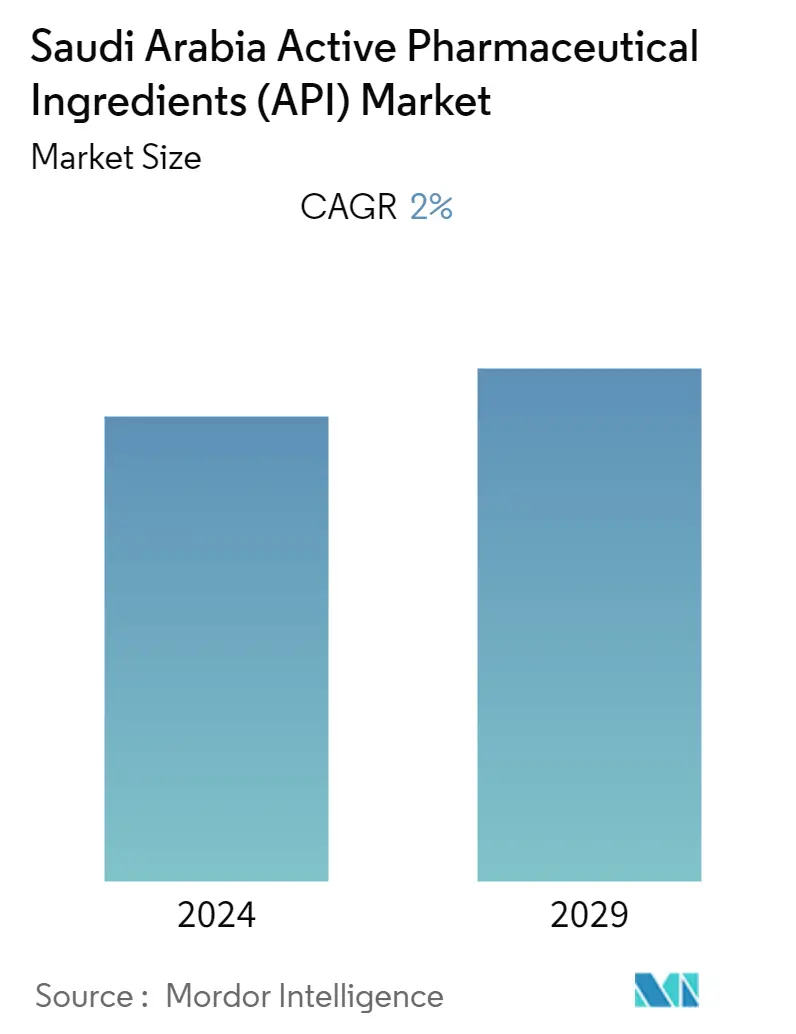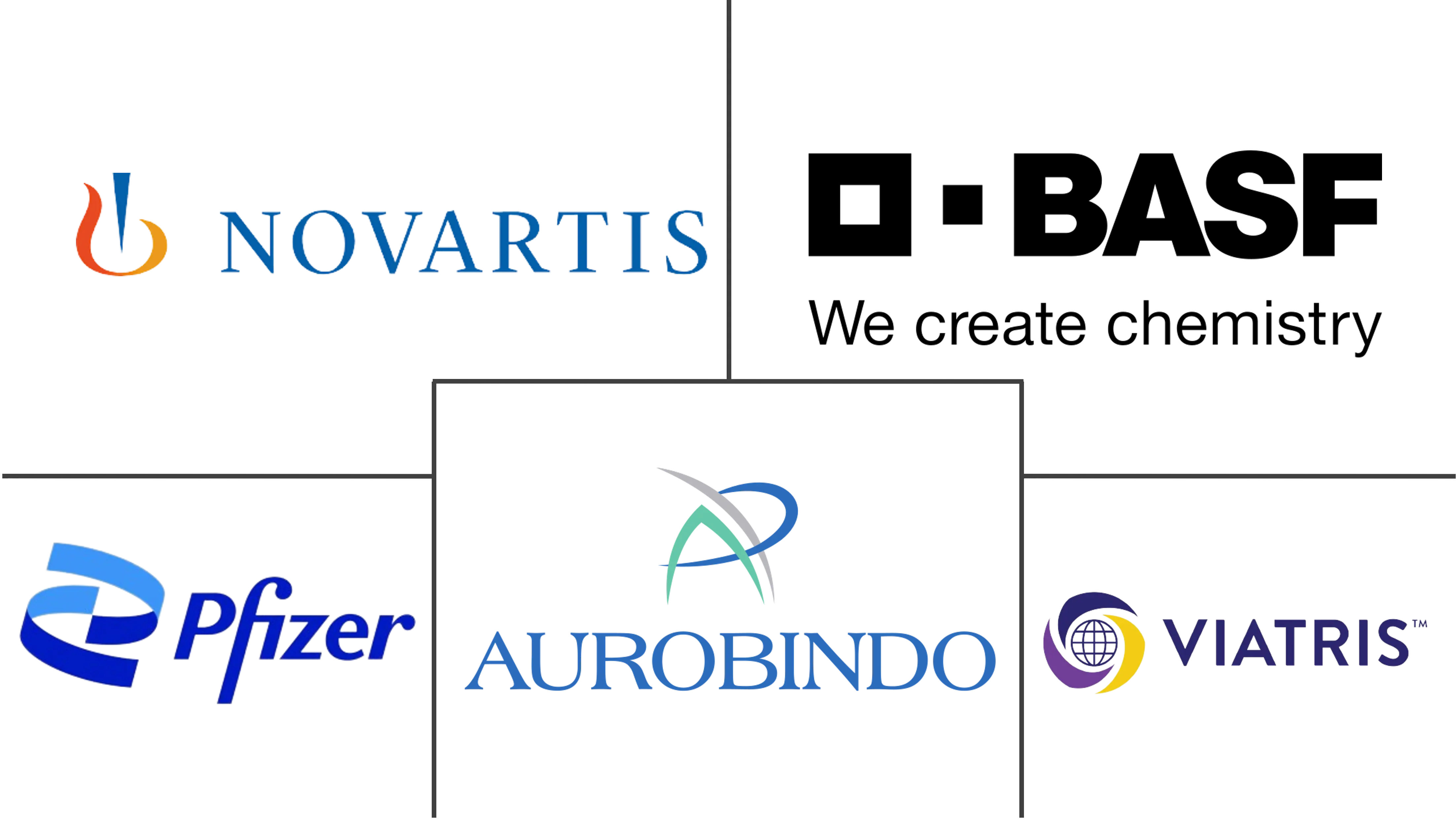Market Size of Saudi Arabia Active Pharmaceutical Ingredients (API) Industry

| Study Period | 2019 - 2029 |
| Base Year For Estimation | 2023 |
| Forecast Data Period | 2024 - 2029 |
| Historical Data Period | 2019 - 2022 |
| CAGR | 2.00 % |
Major Players
*Disclaimer: Major Players sorted in no particular order |
Saudi Arabia Active Pharmaceutical Ingredients (API) Market Analysis
The Saudi Arabian Active Pharmaceutical Ingredients (API) market is expected to register a CAGR of 2% over the forecast period.
The COVID-19 pandemic has not only impacted the entire pharmaceutical supply chain, but more specifically, it disrupted the supply of APIs from India and China. This has increased the cost of many prescription medications and a shortage of essential drugs. For instance, from an article published in July 2021, there was a shortage of essential medications, such as antibiotics, vitamins, hormones, anti-cancer, anti-hypertensives, anti-diabetics, and steroids, in the country due to the high reliance on India and China for APIs. However, with the released COVID-19 restrictions and the country's resumed import and export activities, the studied market is expected to grow over the forecast period.
Certain factors propelling the market growth are the increasing prevalence of infectious, genetic, cardiovascular, and other chronic disorders, the growing geriatric population, and the expanding adoption of biologics and biosimilars in the country.
The rising burden of infectious and chronic diseases is the key factor driving the market growth. To assess the highest burden of mental disorders, a household survey was conducted by the Saudi National Mental Health Survey (SNMHS). Its report published in February 2022 assessed that neurological disorders, including Parkinson's and epilepsy, were associated with the highest individual-level numbers of days-out-of role. The high burden of Parkinson's disease as a mental disorder among the Saudi population is expected to raise the demand for better treatment drugs. This is anticipated to boost the demand for active pharmaceutical ingredients for manufacturing drugs, propelling the market growth.
The growing geriatric population more prone to developing infectious and other chronic diseases is also contributing to the market growth. For instance, according to the 2022 statistics published by UNPFA, about 72% of the population in Saudi Arabia is between 15-64 years, and 4% is 65 years or above. The data published by MIT Technology Review in June 2022 stated that the population of Saudi Arabia population is aging at an accelerated rate. Thus, the high aging population increases the need for effective drugs for treating various chronic and infectious diseases. This is anticipated to propel the demand for active pharmaceutical ingredients, boosting the market growth.
Furthermore, the healthcare system in the country is actively seeking ways to lower costs and raise revenues. Innovative formulary management provides a way to save prescription prices without sacrificing patient care. Specialty pharmaceuticals are one prominent area in which cost reductions would make a significant difference because of the high cost of biologics, which results in a disproportionate contribution to the total national drug spending. Thus, using less expensive biosimilars offers a chance to reduce drug costs and spending on biologics without compromising patient outcomes. For instance, from a study published in Healthcare Journal in July 2021, it has been observed that researchers in Saudi Arabia recommend utilizing trastuzumab biosimilars rather than the reference product (Herceptin) for treating patients with breast cancer. This switch to biosimilar drugs helps to reduce the high healthcare costs associated with the disease in the country. This is anticipated to increase the production of biosimilar drugs which is further expected to increase the demand for API in the country over the forecast period.
Moreover, the rising company focus on developing pharmaceutical products, increasing drug approvals, and investments in the country contribute to market growth. In November 2021, BeiGene, and NewBridge Pharmaceuticals stated that BRUKINSA (zanubrutinib) received approval from the Saudi Food and Drug Authority (SFDA) for the treatment of adult patients with mantle cell lymphoma (MCL) who have received at least one prior therapy.
Therefore, owing to the aforementioned factors, the studied market is expected to grow over the forecast period. However, the country's stringent regulations and drug price control policies are expected to impede the growth of the active pharmaceutical ingredients industry in Saudi Arabia over the forecast period.
Saudi Arabia Active Pharmaceutical Ingredients (API) Industry Segmentation
An active pharmaceutical ingredient (API) is a part of any drug that produces its effects. Some drugs, such as combination therapies, have multiple active ingredients to treat different symptoms or act in different ways. They are produced using highly technological industrial processes, both during the R&D and the commercial production phase.
The Saudi Arabia Active Pharmaceutical Ingredients (API) Market is Segmented by Drug Type (Branded and Generic) and Application (Cardiology, Oncology, Neurology, Orthopedic, Ophthalmology, and Other Applications). The report offers the value (in USD billion) for the above segments.
| By Drug Type | |
| Generic | |
| Branded |
| By Application | |
| Cardiology | |
| Oncology | |
| Neurology | |
| Orthopedic | |
| Ophthalmology | |
| Other Applications |
Saudi Arabia Active Pharmaceutical Ingredients (API) Market Size Summary
The Saudi Arabian Active Pharmaceutical Ingredients (API) market is poised for growth over the forecast period, driven by several key factors. The market is recovering from disruptions caused by the COVID-19 pandemic, which had significantly impacted the supply chain, particularly affecting the availability of APIs sourced from India and China. This reliance led to increased medication costs and shortages of essential drugs. However, with the resumption of import and export activities, the market is expected to expand. The rising prevalence of infectious, genetic, and chronic disorders, coupled with an aging population, is fueling demand for APIs. The growing adoption of biologics and biosimilars further supports market growth, as these alternatives offer cost-effective solutions without compromising patient care. The healthcare system's focus on reducing costs while maintaining quality care is driving the production of biosimilars, which in turn boosts the demand for APIs.
The oncology and branded segments are anticipated to experience significant growth, driven by the increasing burden of cancer and chronic diseases such as diabetes and cardiovascular conditions. The rising incidence of cancer, particularly among younger populations, necessitates advanced treatment options, thereby increasing the demand for APIs. The high prevalence of non-communicable diseases and congenital heart conditions further propels the need for pharmaceutical drugs. Additionally, the market is witnessing increased company activities, including research and development, partnerships, and product launches, which are expected to enhance the availability and demand for APIs. Despite the fragmented nature of the market, with dominant players from China and India, local initiatives and investments in drug development and manufacturing infrastructure are poised to strengthen the market's growth trajectory.
Saudi Arabia Active Pharmaceutical Ingredients (API) Market Size - Table of Contents
-
1. MARKET DYNAMICS
-
1.1 Market Overview
-
1.2 Market Drivers
-
1.2.1 Increasing Prevalence of Infectious, Genetic, Cardiovascular, and Other Chronic Disorders
-
1.2.2 Growing Geriatric Population
-
1.2.3 Increasing Adoption of Biologicals and Biosimilars
-
-
1.3 Market Restraints
-
1.3.1 Drug Price Control Policies
-
1.3.2 Stringent Regulations
-
-
1.4 Industry Attractiveness - Porter's Five Forces Analysis
-
1.4.1 Threat of New Entrants
-
1.4.2 Bargaining Power of Buyers
-
1.4.3 Bargaining Power of Suppliers
-
1.4.4 Threat of Substitute Products
-
1.4.5 Intensity of Competitive Rivalry
-
-
-
2. MARKET SEGMENTATION (Market Size by Value - USD million)
-
2.1 By Drug Type
-
2.1.1 Generic
-
2.1.2 Branded
-
-
2.2 By Application
-
2.2.1 Cardiology
-
2.2.2 Oncology
-
2.2.3 Neurology
-
2.2.4 Orthopedic
-
2.2.5 Ophthalmology
-
2.2.6 Other Applications
-
-
Saudi Arabia Active Pharmaceutical Ingredients (API) Market Size FAQs
What is the current Saudi Arabia Active Pharmaceutical Ingredients (API) Market size?
The Saudi Arabia Active Pharmaceutical Ingredients (API) Market is projected to register a CAGR of 2% during the forecast period (2024-2029)
Who are the key players in Saudi Arabia Active Pharmaceutical Ingredients (API) Market?
Pfizer, Inc., Aurobindo Pharma, Novartis AG, BASF SE and Viatris Inc. are the major companies operating in the Saudi Arabia Active Pharmaceutical Ingredients (API) Market.

